The Lonton Egg & Teesdale Feat Stone
Guest article by Calum Stott
I’ve been hunting stones of strength in England since the start of 2024, convinced stonelifting culture in Britain can’t be confined to Scotland and Wales. After digging into past research by Peter Martin and Roger Davis, I had a few leads to get me started.
My first lead came from the Iron Mind forums and small local news articles about a “new” stone Roger sourced in 2012 to resurrect stonelifting culture in England.1 2 The Vernacular Architecture Revival Inititive (VAR) organized a stone festival at the Bowes Museum in Teesdale to “show to the UK that this is a stone-mad part of the world.”1
Building on Teesdale’s strong history with stone (it’s been mined for its impressive geology for centuries), the festival was to celebrate all things stone, with exhibitions by stone masons, sculptors, artists, and drystone wallers. But a stand-out event was the competition to lift a smooth whinstone boulder, named the Teesdale Feat Stone, from the ground to a wooden table.
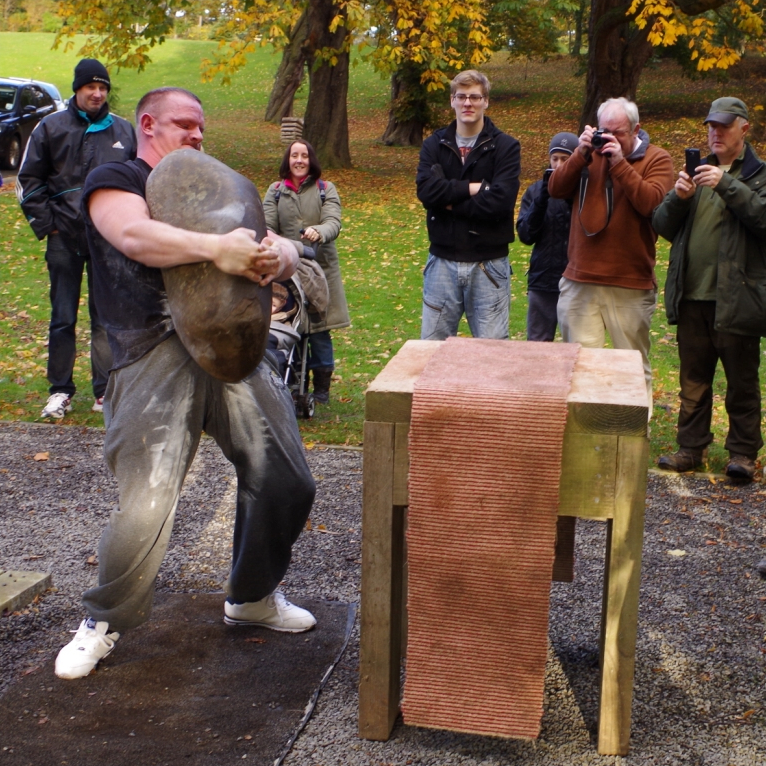
Sadly, since the event in 2012, other than brief mentions online, it appears the stone had vanished. I emailed the Bowes Museum and spoke to the events manager, but no one knew of the stone. And after speaking with fellow stone hunters, it turns out no one else knew of it either.
My next contact was the event organisers, VAR, whose online presence was somewhat lacking. Thankfully I was still able to find a working email for one of the trust’s members. After a week of hoping for a response, my patience was rewarded with a name. The trust member told me that a local drystone waller, Ewan, was the main organiser of the festival – he would be the best man to ask.
By chance, another contact from my social media searches also replied, saying that a drystone waller by the same name was the person they spoke to at the festival 12 years ago. I knew I was on the right track.
I searched for Ewan online and found his website describing him as a master craftsman drystone waller and sculptor based in Edinburgh. Could he be one and the same? I got in touch via email and through Facebook to cover both bases. He responded almost immediately and was pleasantly surprised to find someone still interested in the Teesdale Feat Stone after so many years. He confirmed that he and Roger selected and heaved the stone out of the River Tees.
Although Ewan now lived in Edinburgh, he said the stone should still lie in a field close to where he lived in Lunedale, near Middleton-in-Teesdale. To say I was over the moon was an understatement! He said he would speak to a local resident to see if they could locate the Teesdale Feat Stone and then gave me the number of Andrew the farmer, whose land he believed it still sat on. Even though I’d not seen it yet, just getting a nibble of confirmation was a rush.
To top it off, after exchanging several messages, Ewan casually mentioned that there was in fact a historic lifting stone sat in a private garden nearby as well. I jumped off the sofa after reading that last sentence! My wife already thinks me mad, but now she’s convinced I’ve gone stone mad as its “all I seem to talk about these days.”
Ewan began to tell me the story of the Lonton Egg, a large, smooth, and as the name suggests, egg-shaped stone that sits in the garden of an old smithy. In an age gone by, after a few pints, young men would challenge each other to lift the Lonton Egg on the walk home from the pub. Ewan and Roger had politely tried to gain access to the garden around the time they pulled the Teesdale Feat Stone from the river, but were chased off by the owner.
A lead on a real historic challenge stone here in England! England does have some historic ‘Feat Stones’ – stones used in incredible feats of strength by one person, like the Blue stone of Old Hartley or The Giant’s Stone. But the Lonton Egg is a bit more special, it’s the first historic stone in England I’ve heard of akin to the Scottish Clach Thogalaich: stones used in weightlifting contests.3 If I wasn’t bitten by the bug to hunt for lost stones before, I was certainly addicted now.
After some more research online, although unable to find a phone number for the old smithy, I came across the neighbouring farmer’s number. Being a farmer myself I thought why not give him a ring and see what he knows. By some remarkable stroke of chance, the neighbouring farmer, called John, was the same man who gave Ewan the story of the Lonton Egg in the first place. In fact it was access through his fields that they had dragged the Teesdale Feat Stone from the river. And it was John’s neighbour, Raymond who chased Ewan and Roger out of his garden – he was very protective of the Lonton Egg and valued his privacy.
Raymond passed away in 2023, leaving the house to his daughter Gillian who was renovating the property while living in nearby Middleton. John shared her phone number and wished me good luck in my hunt. Another step closer.
I left a message with Gillian, explaining who I was, what I was hoping to do, and asking if the Lonton Egg was still there. That evening she called back: she was more than happy for me to come and see the Lonton Egg, it was still sat in the corner of the garden, hidden under a bush.
I couldn’t help but wonder what the chances were: that the first number I called was the old farmer who still held the story of the Lonton Egg, and – 12 years after the last visitor had been chased off – I’d been welcomed by the stone’s new guardian.
By the end of the next week I hadn’t stopped thinking about the Lonton Egg. We had a free day that weekend, so I asked my heavily-pregnant wife if she’d like to go for a ride out up to Middleton-in-Teesdale for lunch... and possibly call in and look at a stone if I could get a hold of Gillian by the next morning. Despite being a week off her due date, she obligingly agreed.
Having confirmed I could visit the smithy, I decided to ring Andrew the farmer to see if I could access his land to search for the Teesdale Feat Stone whilst in the area, but sadly had to leave another message on an answer phone.
Sunday morning saw us all set off up the hill to Teesdale. With it being only a 45-minute drive, the journey wasn’t so bad. We arrived at the smithy in Lonton, where we were greeted by Gillian and her husband, Tom. The smithy is a charming old house sat along the old road between Middleton and Mickleton, with a stunning garden at the back, complete with a pond, a wooden summer house, and an immaculately kept lawn.
After our introductions and pleasantries, they led us towards the rear of the garden to some bushes and flowerbeds. Gillian rummaged around under one of the bushes and while pulling back the foliage said “This is the Lonton Egg.” My eyes widened and I must have had the biggest smile on my face. Tom chuckled, “Is this what you were looking for then?”
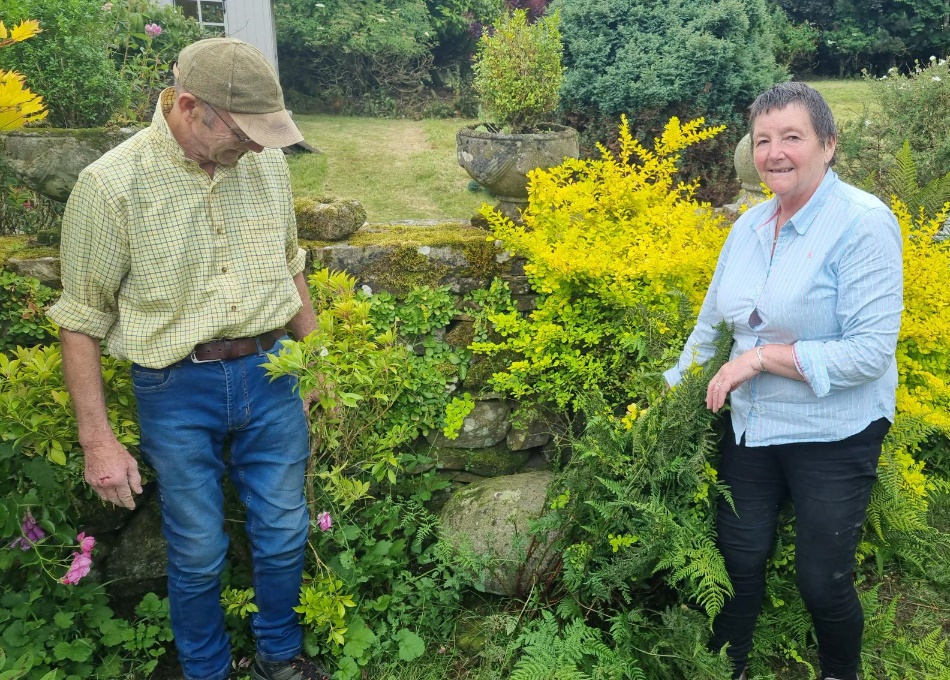
I went to roll the stone out from the bush and into the middle of the lawn, thinking to myself this is a much bigger stone than I think I’ve ever lifted. As it rolled over, I could immediately see it was dead smooth with a large indent on one side providing very little in terms of handles or grip.
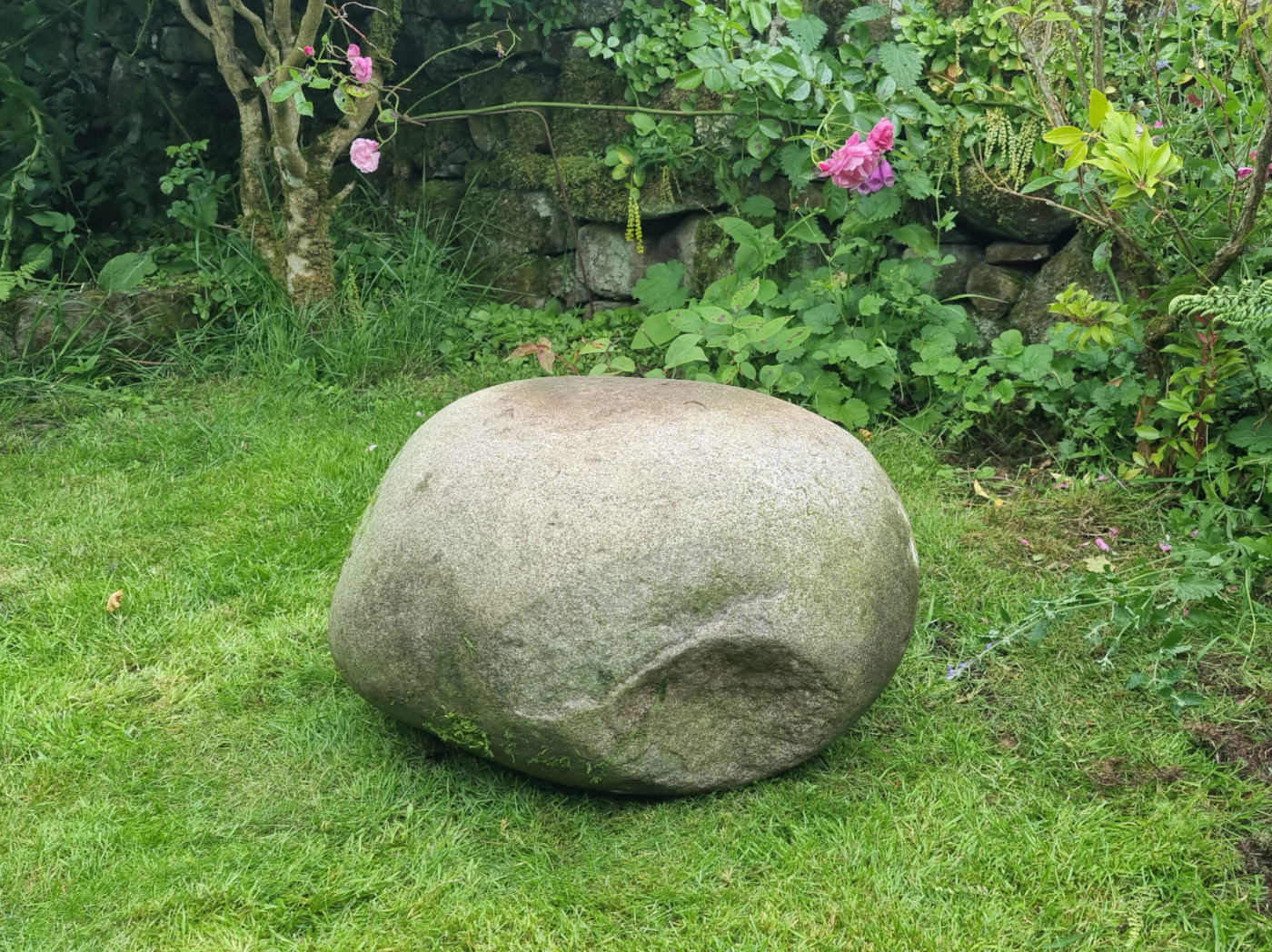
Determined to give it a good go I turned the stone, feeling my way across its surface, searching for an angle or hold that might give me some leverage. With each attempt, I planted my feet wide, bent down, and strained to budge it. But the stone seemed glued to the earth with every attempt to pull it from the turf. Tom chuckled as I panted, “It’s a big old weight is that! You’ll never get it off the floor, you’ll wreck your back trying.” Defeated for the moment, I stood up, stretched my back, and let my arms rest. That’s when Gillian told me that sometime in the ’60s, her uncle – after hearing the stories while visiting her father – decided to try and lift it. And he even managed to lift it a few inches off the ground!
It was one thing to be challenged by men from over a hundred years ago, but to hear that someone had lifted it in Gillian’s lifetime really lit the fire in me. I gave it a few more turns, grasped the stone, and pulled as hard as I could until it rolled and slipped from my grip.
I was slowly coming to the realisation that this stone might just be beyond my reach for now. My wife will have been getting tired of watching me struggle, my little lad was getting hungry and running out of patience, and I was aware I had taken up at least an hour of Gillian and Tom’s time. I told them that I’d just give it one more go then call it quits and admit defeat.
So I rolled it back around and found my footing, bent down low and wrapped my arms as far under the stone as I could wedge them. I pulled it tight to my chest and strained with all my might. With strength that felt as if it came from somewhere else, the stone rose up! Only for a second. Only a couple of inches. But it came up! Wind passed under the Lonton Egg for the first time in maybe 60 years! I jumped up and roared in excitement!
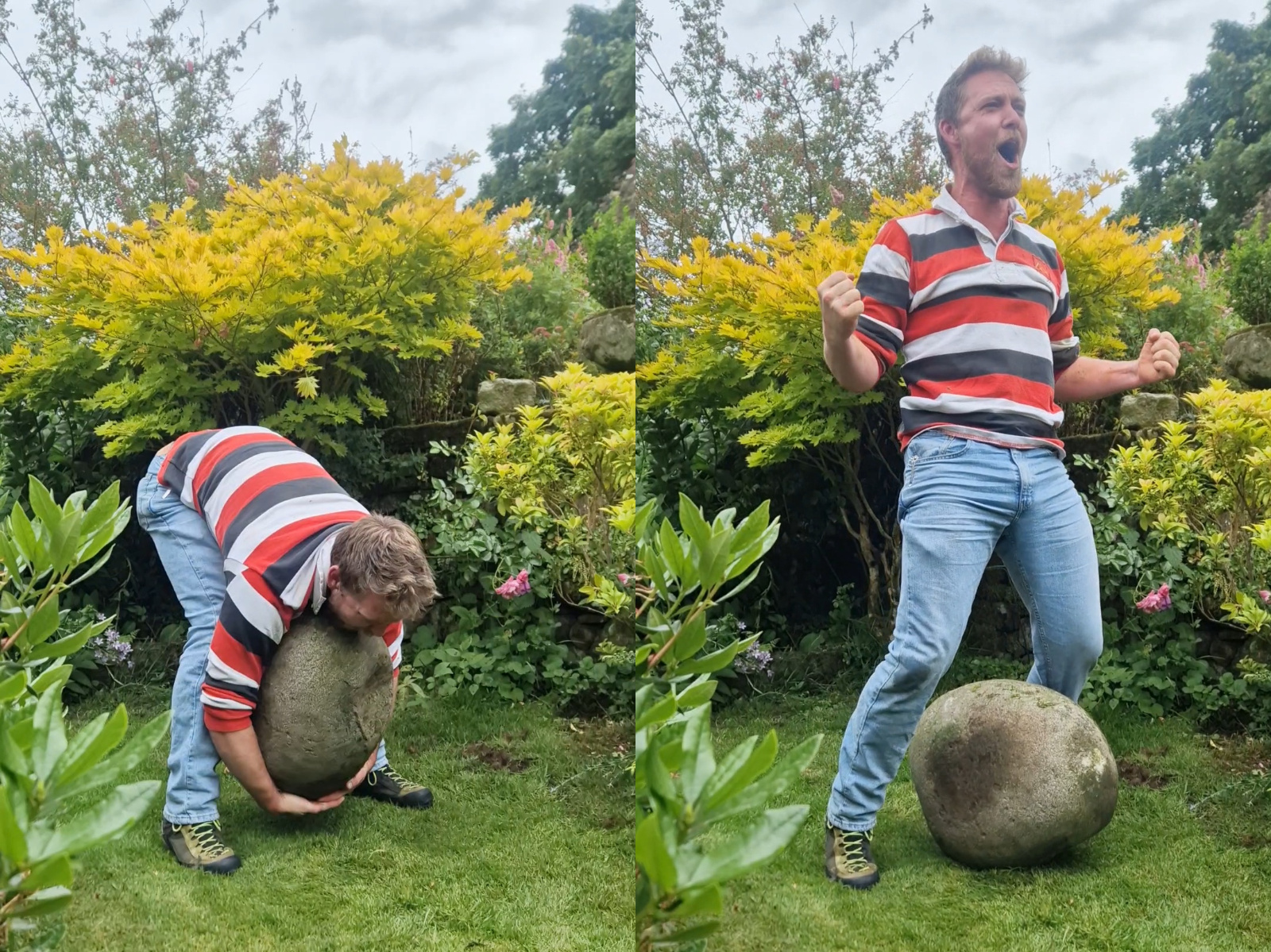
That was it – I had lifted my first historic stone, adding my name to the unwritten list of countless men who had lifted the egg before me. I was on an unbelievable high!
Before we said our goodbyes, I took the scales I’d removed from my lamb weigh crate and attempted to weigh the stone using some rope and an old fence post. I got a rough reading of 131kg (289 lb), but how accurate that is, is anyone’s guess (we’ve since re-weighed it at 130kg (287 lb)). I thanked Gillian and Tom again for letting us into their garden and allowing me to lift the stone.
I had been waiting for the right moment to ask if they would allow others to come to lift it, but before I could, Gillian came out and said she understood how important it was to keep the story of the stone alive and suggested that if any others wanted to attempt to lift it, they could get in contact. She asked if I would help by fielding requests so they only had one person to deal with. I humbly accepted.
I couldn’t leave the area without calling in on John the farmer to let him know that the Lonton Egg was indeed still there and that (incredibly) I’d even managed to lift it. He was amazed as well! I didn’t want to disturb him for long, but once he started talking, nothing was going to stop him. He told us about the history of his farm and how he had been born at there a massive 93 years ago. In all his years, even though he’d known his neighbour Raymond quite well, he’d never even seen the Lonton Egg, so was delighted when I showed him a picture of it.
When John’s father moved to the farm in the 1920s, he heard stories that people were still lifting the Lonton Egg just a few years earlier. John told me that people would pass through Lonton on their walk between Mickleton and Middleton because they could drink for longer. Apparently, pubs in Mickleton would close earlier than in Middleton: The Beer Act of 1840 required public houses in rural areas to close at 10pm, whilst pubs in places with a population over 2,500 – like Middleton – could close at 11pm instead.4 5 6 So, the young men of the dale would head off to Middleton for a few more pints to continue their night. Then on the walk home from the pub, they would pass the old smithy and challenge each other to see who was the strongest by attempting to lift the Lonton Egg as high as possible. By the time John’s father arrived in the 1920s, the custom had faded away. It’s plausible the Great War played a part in ending the stone’s challenge, as the loss of life and social change during the war often disrupted local customs. Luckily, the stone itself was safe at the old smithy and people like John still knew its story.
After our successful morning we took off for lunch and decided to sit in the sun outside a café in Middleton-in-Teesdale. I couldn’t stop going over what had just happened. But then my phone started ringing; a call from an unknown number. I certainly owed my wife and son some family time, so I ignored it. It rang again; it must be important. Stepping aside, I answered the phone – it was Andrew the farmer from up the dale. He was planning to mow some of the fields near where Ewan used to live and mentioned he’d keep an eye out for the stone. He asked whether I knew where the stone might be. I didn’t. But I would be passing by on our way home, I’d happily stop and help search. Once again, I went to my wife with a request for just one more stop.
We pulled up at the farm yard in Lunedale and could hear the whirr of the mower in the distance. My little boy is tractor-mad and was desperate to find it, so we left Hannah in the car and went searching.
Andrew saw us in the gateway and came over to introduce himself. He was sure that it was this very field that Ewan had left the Teesdale Feat Stone, as this was where Ewan had been doing some walling before moving away. I wasn’t in any way hopeful we’d find it though; there was a thick bed of nettles at least 10-feet deep from the wall.
We both walked along one length of the wall, seeing nothing other than a cam stone that had fallen from the top. I continued along the length of the wall closest to the farm house and through a single tyre track in the nettle bed where the tractor had been. Half way along, peeking into view, was a rounded bluish boulder similar in size and shape to the one I’d read about.
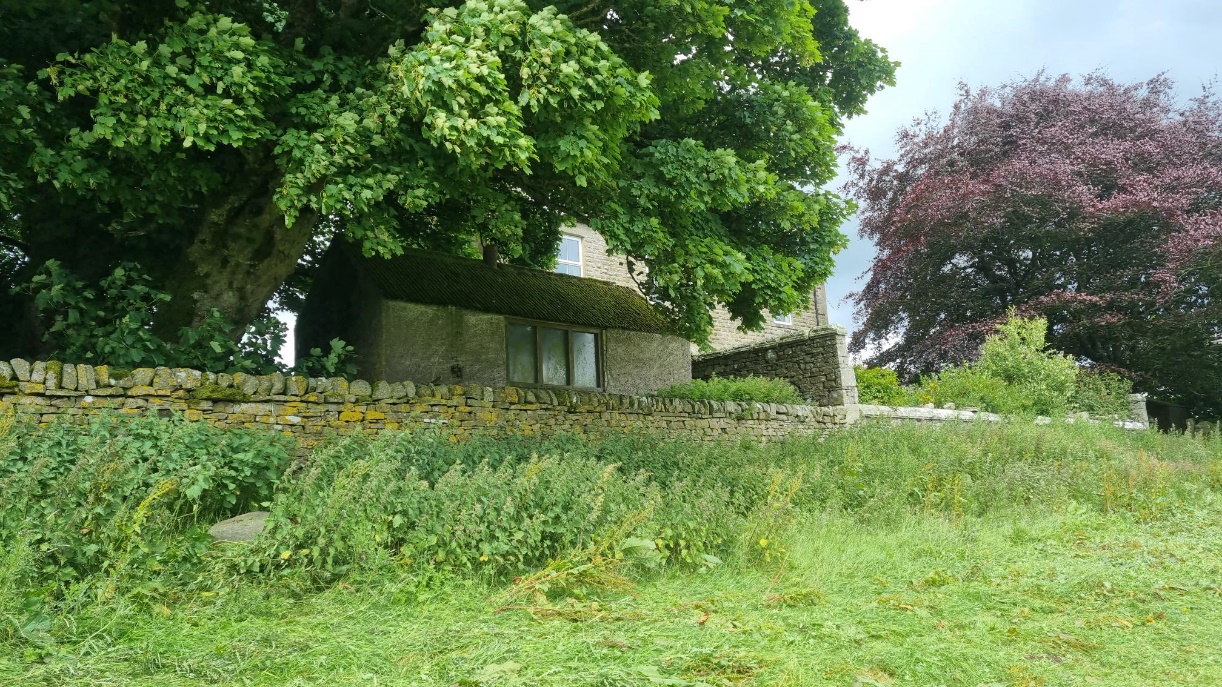
I couldn’t be sure it was the Teesdale Feat Stone, so I tried ringing Ewan to confirm this was it, but no answer.
Instead, I pulled up some old photos of Roger Davis lifting the stone at the stone festival to see if there were any identifying features like chips or marks. In the photograph, I noticed a distinctive cream-coloured circular patch of lichen on one face of the stone.
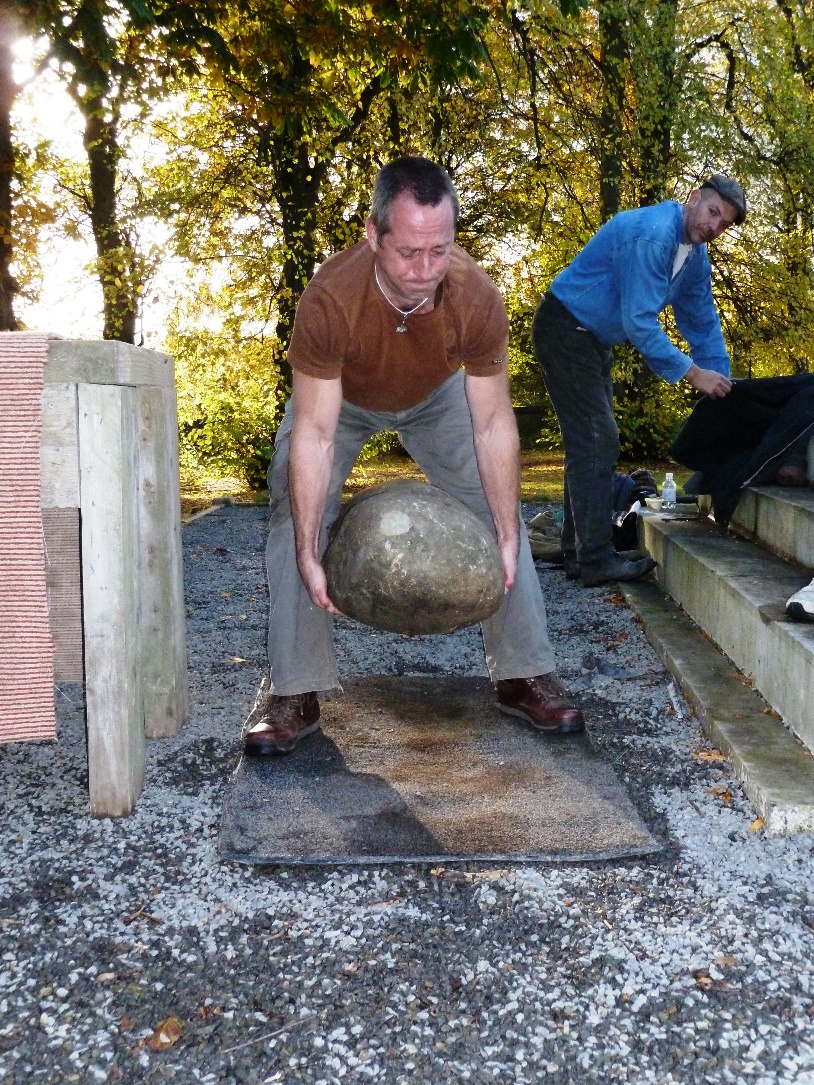
I held my phone up alongside the boulder lying there in the nettle bed, and sure enough there was that same patch of lichen on one end.
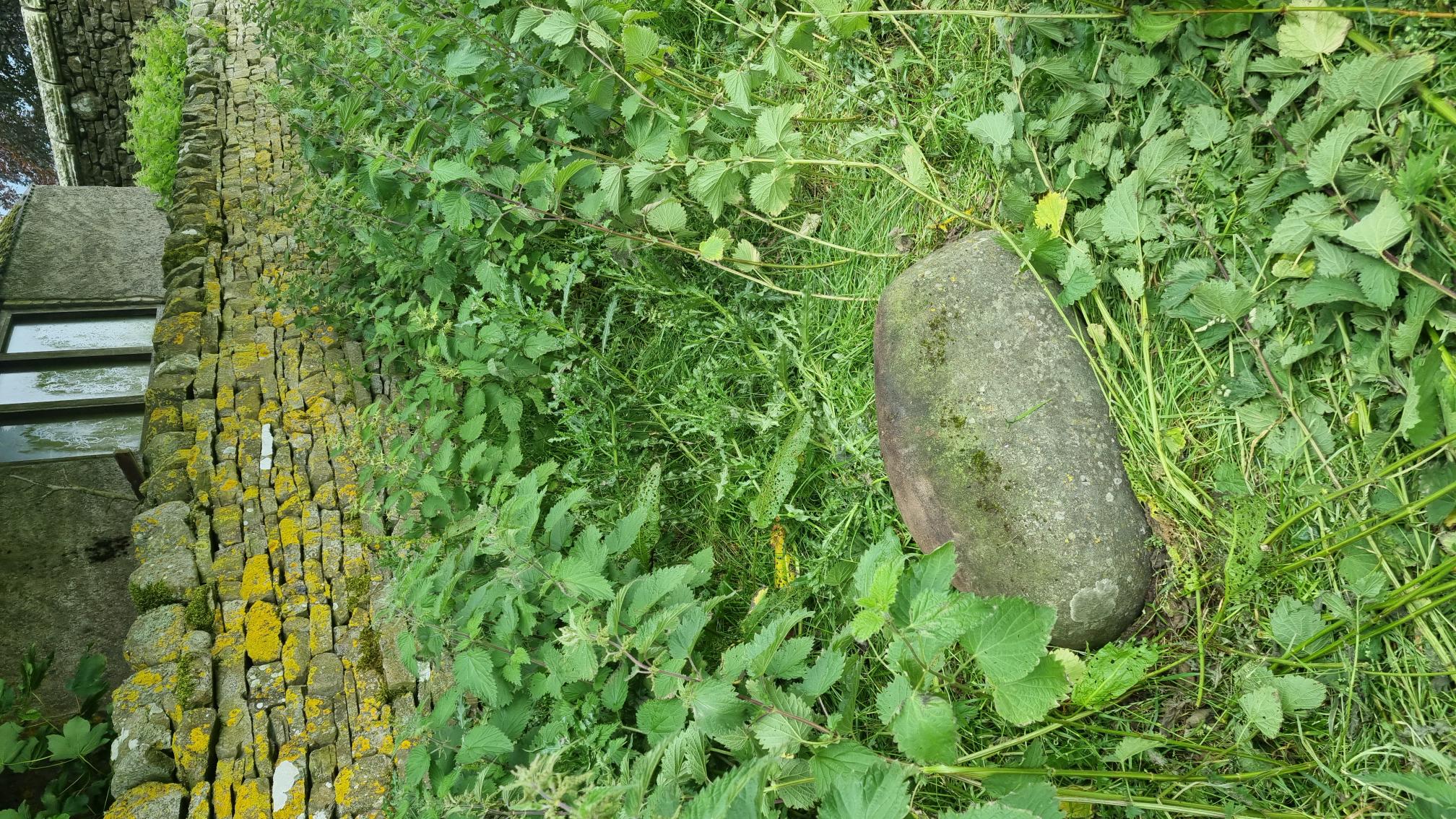
I rolled the Teesdale Feat Stone out of the nettle bed and closer to the wall for safety. After my battle with the Lonton Egg earlier in the day, I wasn’t going to even attempt this brute of a stone. Knowing it was safe was good enough for me – I’d be back to find it a new home where people could lift it once more.
With that final piece of the jigsaw complete we set off back home, and I was beaming like a schoolboy. What a day of stone hunting!
I couldn’t believe my luck! What were the chance it had a distinguishing feature like that? What were the chances I’d come on the day the farmer decided to mow that field? What were the chances the tractor would drive right over the nettles to give a clear view of the half-buried stone? What were the chances Andrew would ring on the same day I was in Middleton?
I’ve heard it said before, but it feels like these lost stones want to be found.
A new home for the Teesdale Feat Stone
A couple of weeks had gone by since rediscovering the Teesdale Feat Stone in the pile of nettles at Thringarth, and I’d been talking to our group of stone hunters based in England about moving it somewhere accessible to the public. The stone obviously needed to remain in Teesdale, and some suggested it might be good to return it to Bowes Museum where it had its first lifts. However, to allow unrestricted access, the best place would be somewhere near a public footpath or on open access land, rather than the museum.
Since Ewan was the original guardian of the stone and a resident of Teesdale for many years, I wanted to get his advice on where he thought was best. He told me he came up with an idea years ago to keep the Teesdale Feat Stone in an old sheepfold called ‘Pin Gate’ up on Harter Fell above Lunedale, but never got round to it.
Although it would have been a bit of a trek from the road, the sheepfold ticked all the boxes: it was on open access land, it was in a named and walled enclosure to make finding it easier, and it had incredible views of the valley below. So I had started to look into where folks might park and the best route to get up to the sheepfold.
Not long after, I received an email from Roger Davis sharing some of his MILO articles he wrote around the time be brought the Teesdale Feat Stone to life, as well as some other breadcrumbs on stones in Cumbria and Northumberland.7 8 In one of his articles he names the Teesdale Feat Stone the Middleton Muckle, a name they were apparently calling it at the time, so-called because the stone came from the River Tees near Middleton-in-Teesdale, and for it being a real muckle of a stone!
Muckle: Adj., Adv., N. Of size or bulk: large, big, great (Dialect variant of ‘Mickle’)9
Roger’s mention of Middleton giving the stone its identity got me rethinking potential locations. It would be idyllic to place the stone somewhere with a great viewpoint, but Pin Gate might just put some people off with being so far from the road.
Ewan came back to me suggesting we place the stone next to the Pennine Way footpath. Ewan knew the field belonged to John (the farmer who held the story about the Lonton Egg), which overlooked Middleton-in-Teesdale. And it was from John’s land that Ewan and Roger pulled the stone from the River Tees in the first place. So in a way it would be coming home to rest with its original owner. I fell in love with the idea: it would be publicly accessible from the footpath, and it overlooked Middleton with a great view of upper Teesdale – back on the land it came from.
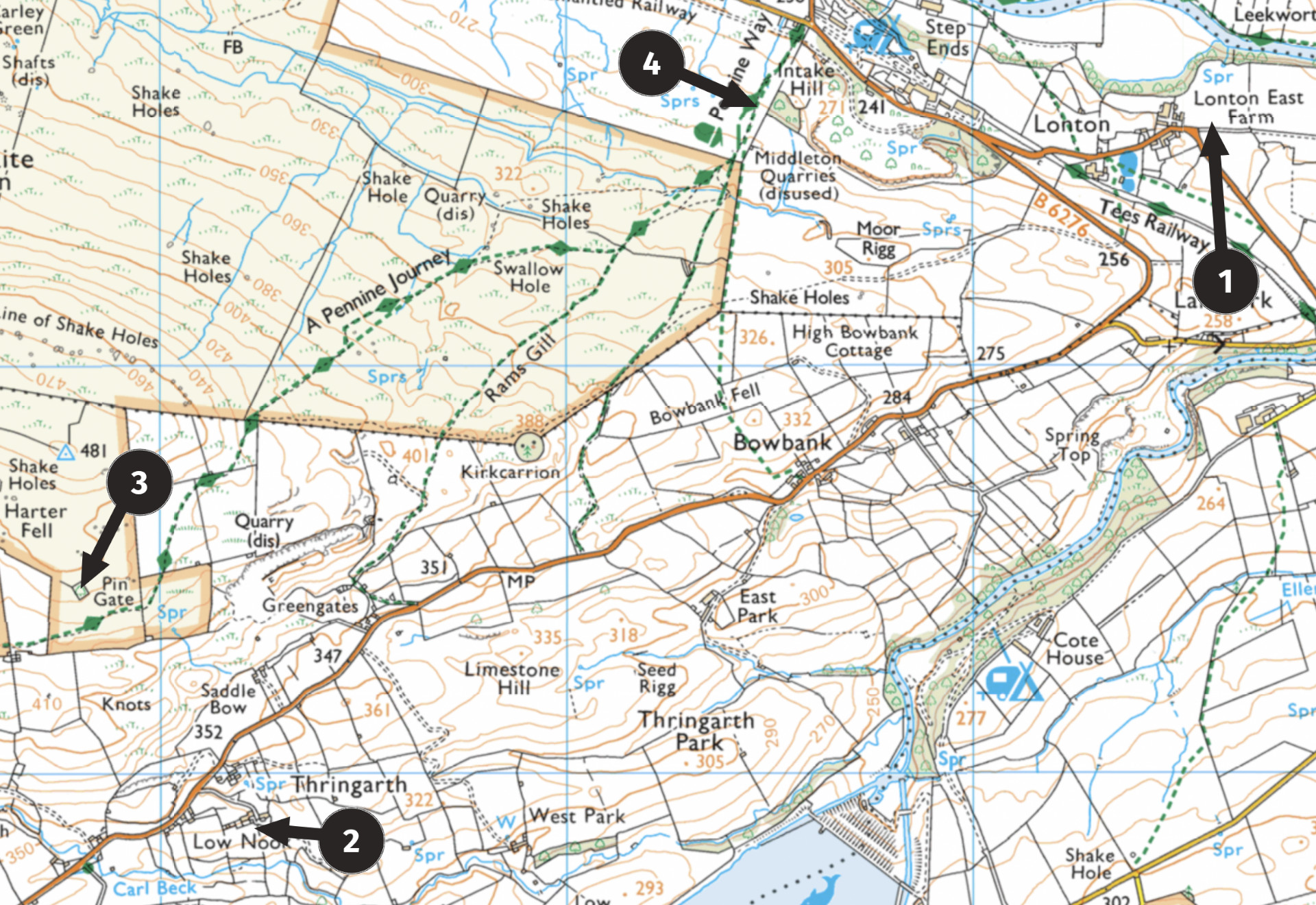
- The farm where Roger and Ewan selected the Teesdale Feat Stone
- The field where I found the stone after so many years
- The sheep fold (Pin Gate) where Ewan first wanted to place the stone
- The Pennine Way footpath where we decided to relocate the stone
And after confirming John was happy for me to place the stone on his land, all that was left was to rehome it.
So, almost a month on from finding the stone, I made the trip back up to Teesdale with fellow stonelifters Harry Reeve and Jono Pritchard who came to help relocate it. I didn’t believe I’d be able to get the it into my pickup alone!
Once we all arrived at John’s farm yard in Thingarth, we drove into the field in my pickup to collect the stone. While pulling in, I noticed two carved faces looking over the fields. Remembering that Ewan was a sculpture as well as a waller, I wondered whether they were his handywork (he later confirmed they were). It feels quite poetic that even though he moved to Edinburgh, in a way he was still looking out for the Teesdale Feat Stone.
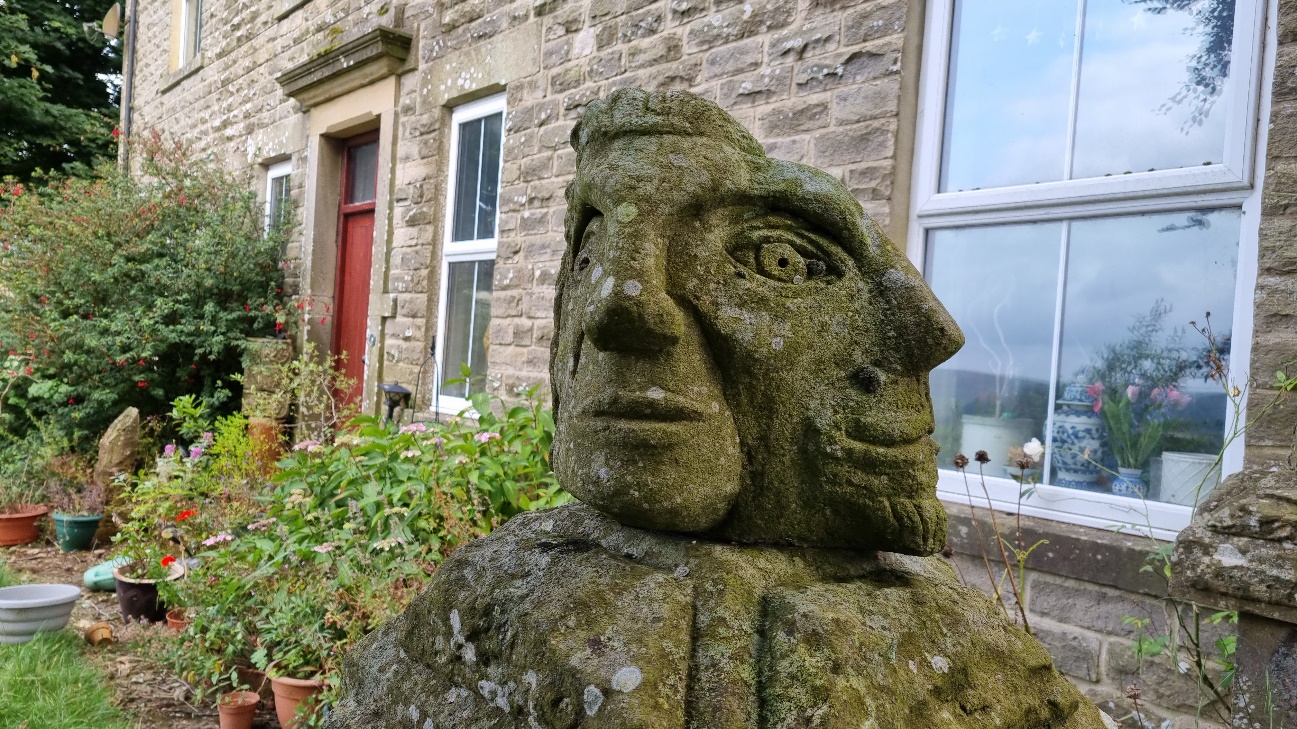
We found the Teesdale Feat Stone in the nettles where I left it a month earlier, and knowing I had some lifting to do later on, I left the job of manhandling the stone into the pickup to Harry and Jono.

There was an air of excitement in anticipation of what was to come as we set off back down the hill to Middleton and the Pennine Way footpath.
It didn’t take long for us to reach the intake field, but the entrance was extrememly tight and the track beyond it was steep – I was unsure we’d even make it through. I shifted into low gear and crept forward with only millimeters to spare either side, hoping not to damage anything.
Once through the tight gap, we started making our way to the top corner of the field where the Pennine Way footpath goes through a stile and onto the fell. I had it in my head that was where we’d place the stone. But about half way up the field we came to a rounded knoll that stood out.
The knoll was high enough to look onto Middleton-in-Teesdale, up the dale to High Force Waterfall, and down towards Eggleston. All three of us jumped out and immediately knew this was the spot. It just felt right.
So I reversed to the top of the knoll and we rolled the stone out onto a crash pad. We all stood there admiring the view, feeling insignificant.
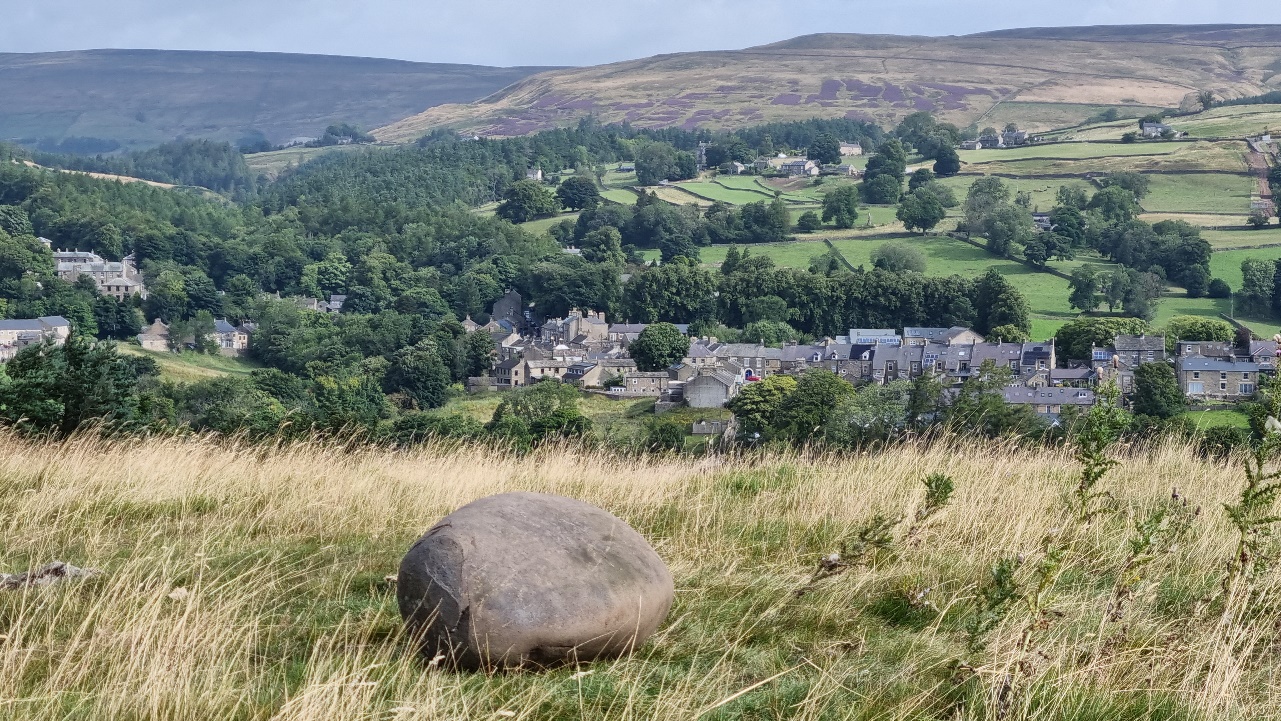
Both Harry and Jono suggested I should have the honour of the first lift. Having seen estimates of it between 120kg and 140kg I wasn’t sure that I would be able to lift it. I had been training with stones since my last visit to Teesdale, but this brute of a stone looked heavy.
Knowing I didn’t yet have the strength yet to lift the stone from its lying position, I levered it up length ways, pointed at the sky. I crouched down low, wrapping my hands round the back of the stone and pulled it in tight to my chest in a bear hug before straining hard to lift it from the floor. But something didn’t feel right; I instantly felt the stone was sat wrong.
I stood up and paused for a second, stretching my back and arms. It was at that point I noticed for the first time since arriving just how strong the wind was up on the fell side.
With the stone still standing straight up, I leant over it for another attempt, this time rotating the stone about 90 degrees so the bottom surface of the stone was now facing my left leg, leaving the two wider edges facing forward and back. In its new position I had to reach a bit further to wrap my arms around the back, but my grip felt stronger and the stone felt tighter in my bear hug. And like a jigsaw piece fitting into place, I knew I had it.
Once again, I pulled the stone hard into my chest, and this time I felt it rise up towards me as if it had been blown into the air. To prove it was me that had lifted the stone – and not the wind – I held the stone for a couple of seconds. Happy with my effort, I released it from my grasp and let it fall a few inches back to its new home on the turf. I had done it. Another stone lifted!
“Right lads, now show me how its done!” I said to Harry and Jono after celebrating my lift with some cheers.
Harry went next, followed by Jono. On both of their attempts, I noticed how well they read the stone by taking their time to feel the stone’s balance and search for the best placement in their hands. When confident with their grip, they comfortably pulled the stone from the ground and securely to their lap, where they made slight adjustments for a stronger position. From there, they extended upwards to put the stone high on their chests and finally wrestled it to their shoulders – showing incredible strength and fortitude. Once balanced, they each held out an arm in victory, proving they conquered the Teesdale Feat Stone before guiding it down to the crash pad below.
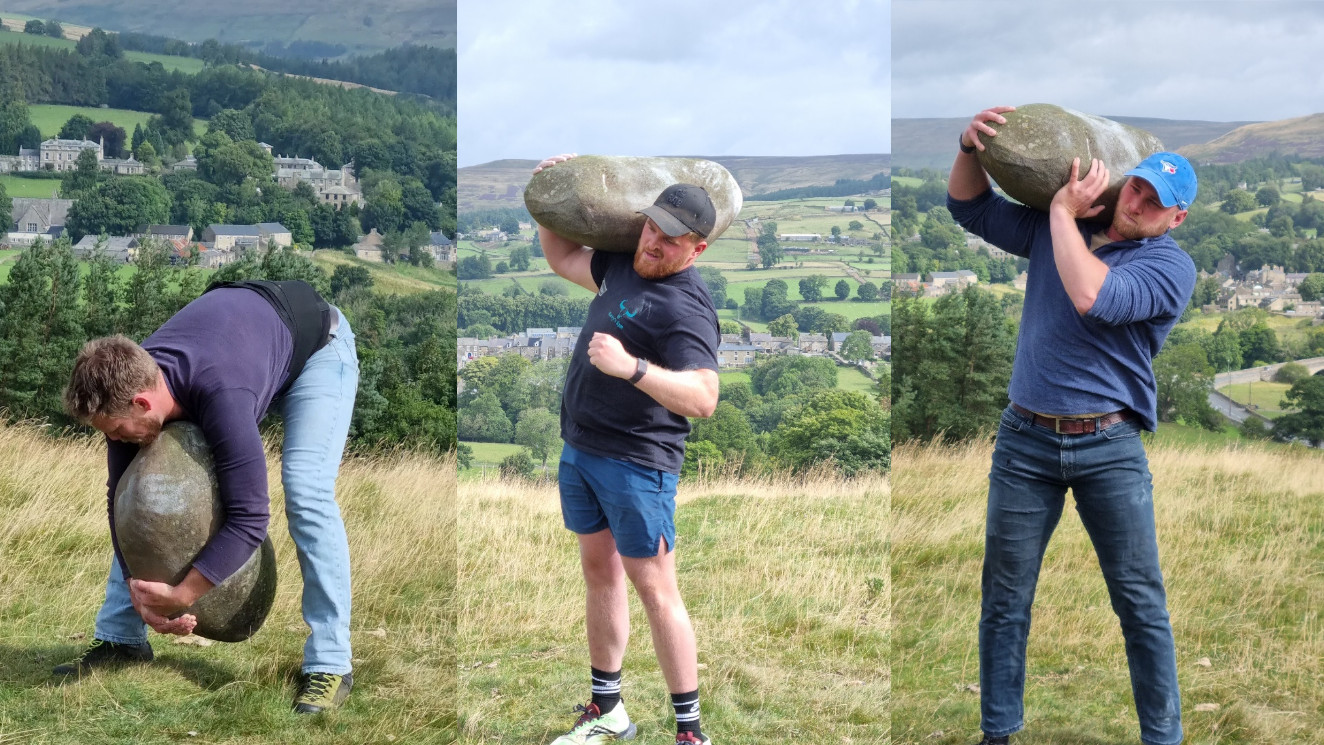
What a morning’s adventure! We were all walking on air.
Before packing up and heading off, we needed to weigh the stone using my trusty portable scales attached to a strap. We each took bets on its weight, Harry picked 133kg, Jono 135kg, and I chose 138kg.
They hoisted the Teesale Feat Stone into the air while I took photos for posterity.
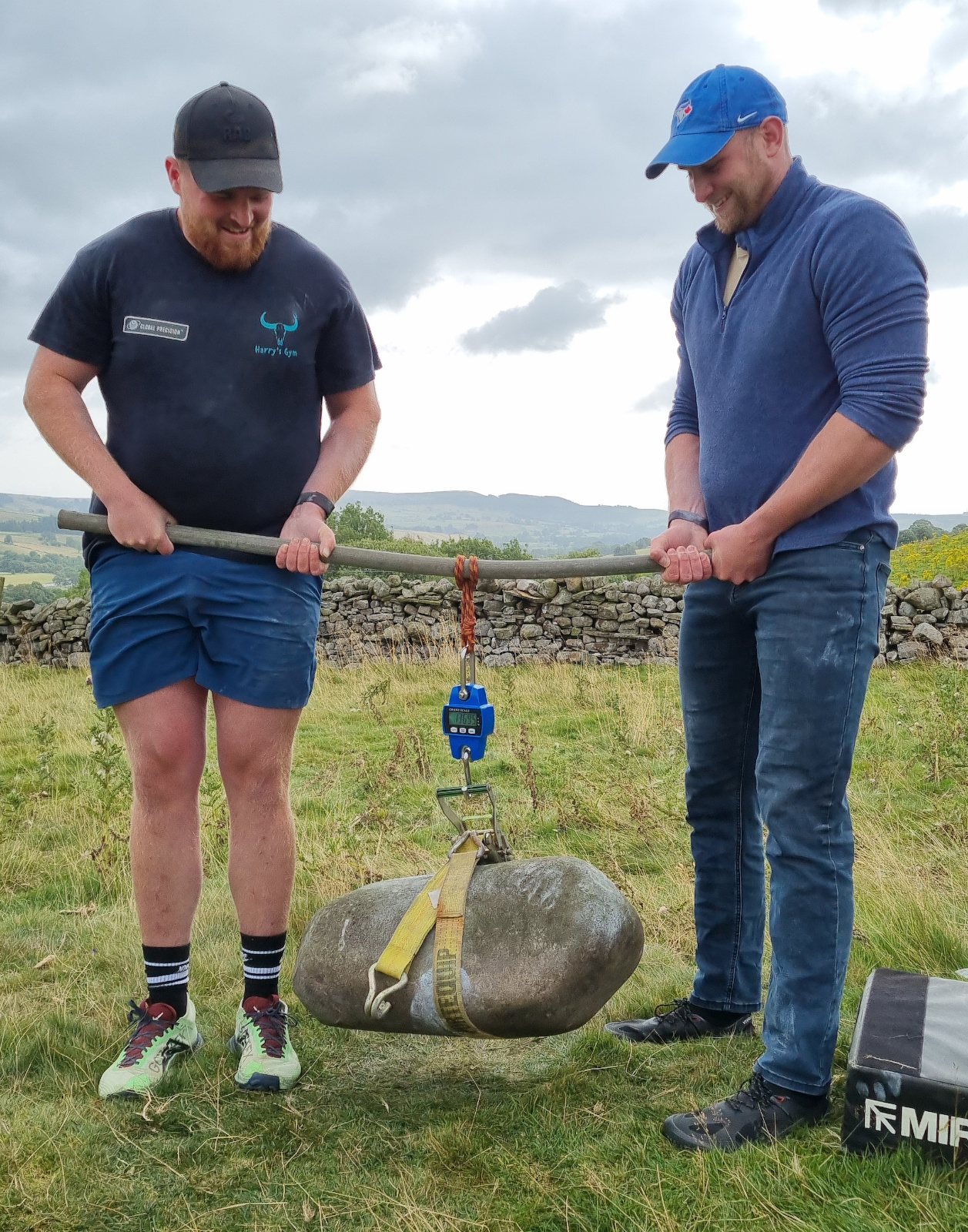
The numbers bounced on the scale around as the stone swayed in the air, eventually settling on 137kg. I was smirking, pretty pleased I’d won the bet! Or so I thought, until I remembered the strap itself weighs 2kg. Jono’s guess was spot on, and the stone had a weight: 135kg (298 lb). My heaviest stone lift so far!
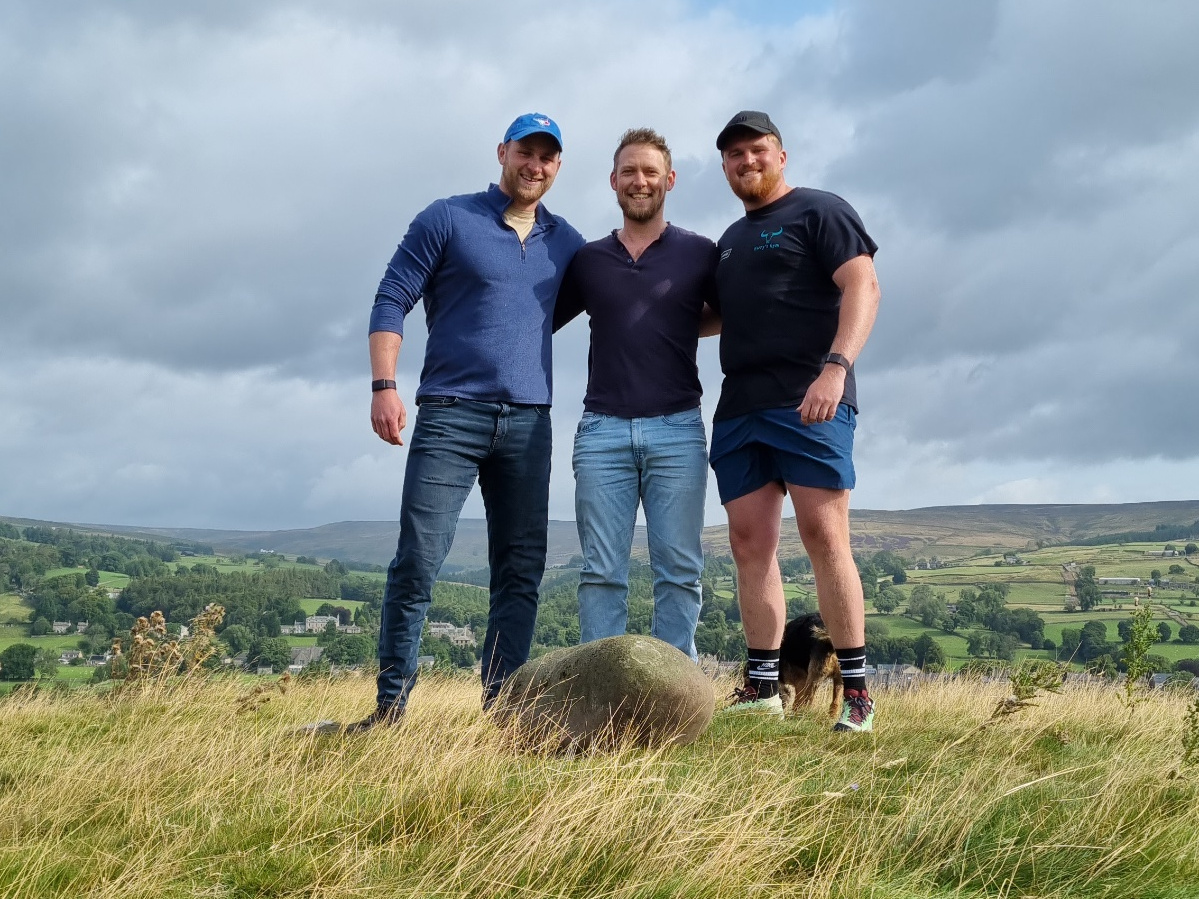
Locations for the Lonton Egg and Teesdale Feat Stone are on the liftingstones.org map. If you’d like to lift the Lonton Egg, please contact me via Instagram so we can arrange a date with Gillian and Tom.
Author
Calum Stott is a farmer and ranger from Cumbria with a passion for local history and folklore. He first encountered stones of strength after listening to David Keohan passionately talk about his own rediscovery of lifting stones in rural Ireland. Since then, Calum has been scouring the North of England to discover lost historic lifting stones and preserve their bygone traditions and stories.
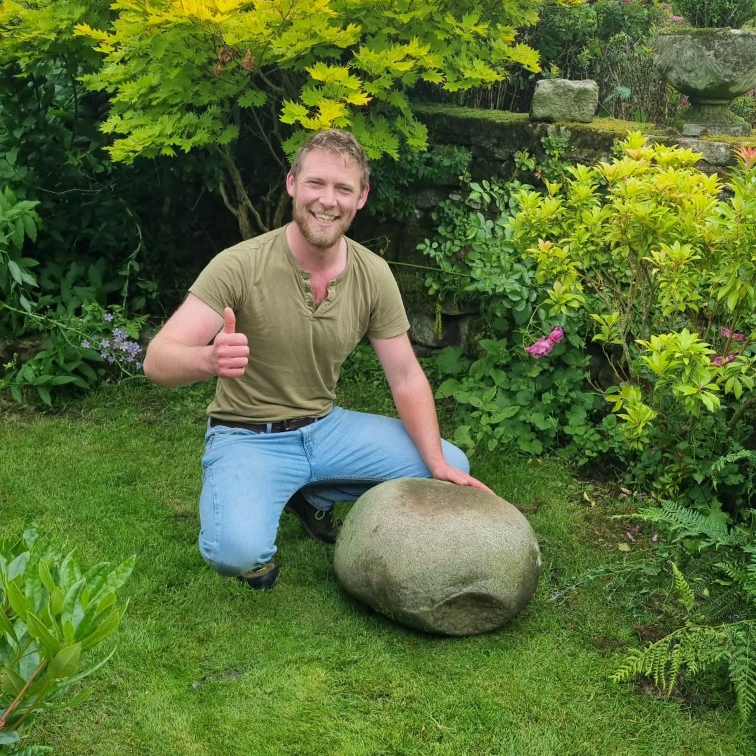
Contributions
I must give a massive thank you to Gillian and Tom for letting me in their garden; John the local farmer for his history; Ewan for first informing me of the Lonton Egg; Andrew for his thoughtful phone call; And of course my wife, Hannah who came with me stone hunting at 39-weeks pregnant!
With massive thanks to Calum for sharing his research and story.
References
-
The Northern Echo: Festival highlighting Teesdale’s stone sector is underway at Bowes Museum, Barnard Castle ↩ ↩2
-
Drink and the Victorians; the temperance question in England, 1815-1872, pg 328, Table 8 (archive.org) ↩
-
GB Historical GIS, University of Portsmouth, Middleton in Teesdale AP/CP through time, Total Population, A Vision of Britain through Time. ↩
-
GB Historical GIS, University of Portsmouth, Mickleton Tn/CP through time, Total Population, A Vision of Britain through Time. ↩
-
MILO Vol 21.2 - English stonelifting revival ↩
-
MILO Vol 21.3 - Bewkley blue stain ↩
Read the liftingstones.org letters
Join thousands of other stonelifters who read the world's most popular stonelifting newsletter.